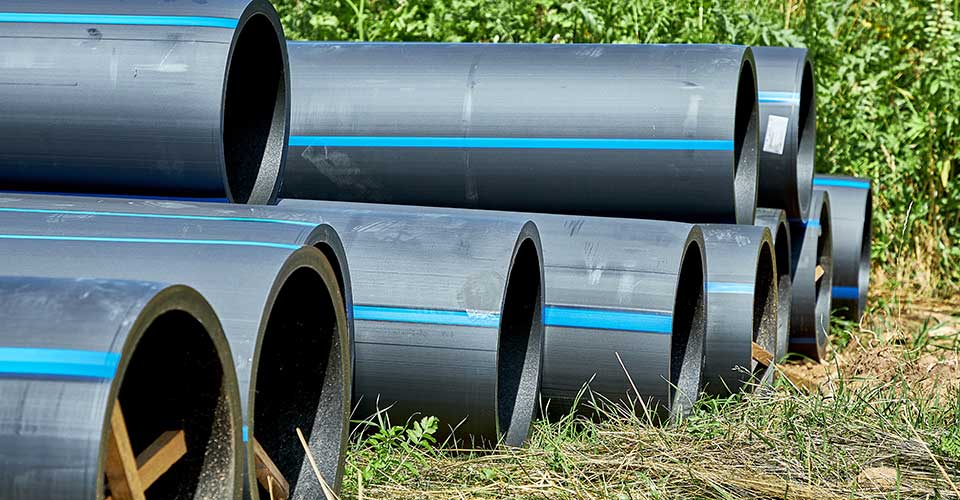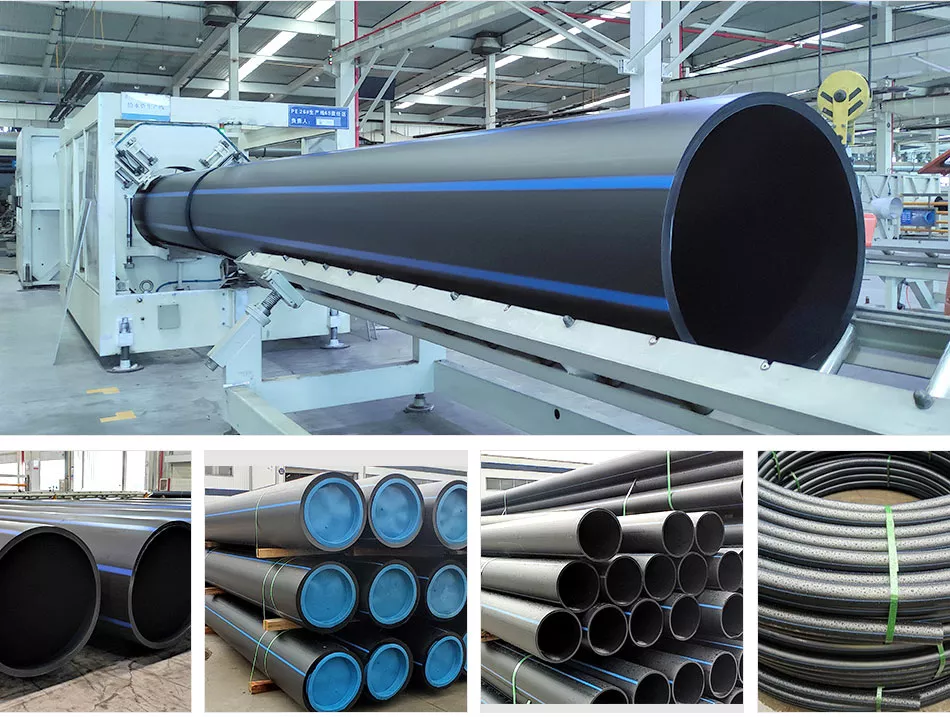Why Partnering with Pipe Supplier American Plastics Midland Ensures Quality Assurance
Explore the Production Process Behind High-Quality HDPE Pipe and Its Applications
The production process of high-quality HDPE pipes is intricate and methodical. It begins with the option of raw products that boost performance. Following this, ethylene goes through polymerization to create material, which is then shaped via extrusion. Quality assurance is paramount, guaranteeing that the end product meets rigorous standards. Nonetheless, the trip of HDPE pipes does not end with manufacturing. Their applications across different markets disclose a more comprehensive significance worth analyzing.
Recognizing HDPE: Residences and Advantages

High-density polyethylene (HDPE) is a functional thermoplastic understood for its toughness and resistance to different ecological variables. This product displays superb tensile strength, making it appropriate for demanding applications. Its low-density structure contributes to a lightweight item, promoting ease of dealing with and setup. HDPE also showcases amazing resistance to chemicals, which lessens destruction when subjected to rough compounds.
The product's reduced dampness absorption even more boosts its durability, making it optimal for usage in pipes and storage space containers. Additionally, HDPE is immune to ultraviolet (UV) radiation, guaranteeing that products preserve their stability even when revealed to sunshine. Additionally, its adaptability enables for the creation of detailed forms without endangering toughness. The environment-friendly nature of HDPE, frequently derived from recycled products, adds to its allure, promoting lasting techniques in production. On the whole, these properties and benefits make HDPE a recommended option for numerous commercial and customer applications.
Resources Choice for HDPE Production
The choice of raw products for HDPE production is important to verify the end product satisfies the wanted specifications and quality requirements. High-density polyethylene (HDPE) is largely generated from polymerized ethylene, stemmed from nonrenewable fuel sources such as all-natural gas or unrefined oil. The high quality of these feedstocks greatly affects the mechanical and thermal properties of the last HDPE.
Ingredients also play a significant role in improving HDPE's efficiency, including anti-oxidants, UV stabilizers, and colorants, which enhance resilience and resistance to environmental elements. The option process need to take into consideration not just the chemical make-up of the raw materials however also their processing characteristics to ensure effective production.
Moreover, the sourcing of resources must prioritize sustainability and compliance with environmental laws, as liable practices are vital in today's market. Eventually, careful basic material selection lays the structure for producing premium HDPE pipes suitable for varied applications.
The Extrusion Process: Shaping HDPE Pipeline
The extrusion process plays an important function fit HDPE pipes, starting with careful product preparation techniques that ensure ideal flow and uniformity. Just as essential is the design of the die, which straight influences the last dimensions and surface area quality of the pipeline. Together, these variables add considerably to the performance and quality of HDPE pipe production.
Product Prep Work Techniques
Efficient manufacturing of HDPE pipes begins with careful product prep work methods, particularly the extrusion procedure. Throughout this phase, high-density polyethylene material is very first dried out to eliminate dampness, guaranteeing optimal flow features. The material is then fed into the extruder, where it undertakes heating and melting, changing into a thick state. This heating procedure is meticulously controlled to maintain the product's honesty and efficiency. The liquified HDPE is compelled with a die, forming it into a continuous pipeline type. Proper temperature management during extrusion is important, as it straight affects the material's residential or commercial properties and the last item high quality. Once formed, the HDPE pipe is cooled down and cut to defined lengths, prepared for subsequent handling and applications.
Die Style Significance
Accuracy in die design plays a crucial duty in the extrusion process of HDPE pipelines. The die functions as the last shaping device, straight influencing the pipe's measurements, wall surface thickness, and surface coating. A properly designed die warranties uniform product circulation, lowering defects such as irregularities and weak areas. The geometry of the die must be enhanced to suit the certain buildings of HDPE, including its thickness and thermal behavior throughout extrusion. In addition, the cooling rate of the product as it travels through the die can markedly influence the pipeline's architectural integrity. Investing in advanced die modern technology is important for manufacturers intending to generate top notch HDPE pipes that fulfill industry standards and client assumptions.
High Quality Control Procedures in HDPE Production
Although various elements affect the top quality of HDPE pipeline manufacturing, efficient quality control steps are essential to assure consistency and reliability in the last product. Key high quality control practices include strenuous material inspection, validating that the raw polyethylene satisfies recognized criteria for pureness and thickness. Throughout the extrusion procedure, parameters such as temperature, stress, and cooling time are closely kept an eye on to keep dimensional precision and structural stability
Additionally, post-production screening is necessary; suppliers commonly conduct hydrostatic tests to evaluate the pipeline's strength and resistance to stress. Aesthetic inspections for surface area flaws even more improve quality control. Accreditation from relevant standards companies, like ASTM or ISO, offers an extra layer of reliability. By carrying out these extensive high quality control procedures, suppliers can minimize defects, improve performance, and guarantee that the HDPE pipelines satisfy the certain needs of various applications, ultimately causing client satisfaction and count on the product.
Applications of HDPE Pipeline Across Industries
HDPE pipelines are made use of throughout various markets because of their durability and flexibility. In water circulation systems, they ensure reliable delivery, while in wastewater management, they provide reputable services for waste transport. Additionally, farming irrigation networks gain from HDPE's resistance to rust and flexibility, making it an optimal option for modern farming methods.

Water Circulation Equipments
A substantial number of industries rely upon high-density polyethylene (HDPE) pipelines for effective water distribution systems. Understood for their durability and resistance to rust, HDPE pipelines are widely utilized in community supply of water networks, agricultural irrigation, and industrial applications. Their light-weight nature helps with very easy handling and installment, reducing labor expenses and time. Furthermore, HDPE pipes can accommodate different stress levels, making them ideal for both reduced and high-pressure systems. hdpe pipe in stock Midland TX. The flexibility of the material permits seamless combination right into existing facilities, lessening the requirement for substantial excavation. Additionally, HDPE's resistance cast iron sewer pipe repair to chemical leaching warranties that the water supplied remains secure and clean, making it a suitable choice for maintaining the quality of drinkable water across different markets
Wastewater Monitoring Solutions
Efficient water circulation systems additionally lead the way for ingenious wastewater management solutions, where high-density polyethylene (HDPE) pipes play a substantial role. Prominent for their durability and resistance to deterioration, HDPE pipes are suitable for transferring wastewater in different setups. Their versatility permits very easy setup in complex environments, minimizing the requirement for substantial excavation. Furthermore, HDPE's smooth interior surface reduces rubbing, enhancing circulation prices and efficiency. These pipes are likewise immune to chemical leaching, making certain that pollutants do not endanger the surrounding environment. Industries, towns, and therapy facilities progressively depend on HDPE pipelines for their dependability and longevity, making them a recommended option for modern wastewater administration systems. This adaptability highlights the essential importance of HDPE get redirected here pipelines across various applications.
Agricultural Watering Networks
Agricultural watering networks benefit greatly from making use of high-density polyethylene (HDPE) pipes, which provide reliable and dependable water distribution to crops. HDPE pipelines are light-weight, making them very easy to deliver and install, while their versatility enables different configurations in diverse surfaces. These pipelines demonstrate exceptional resistance to rust, chemicals, and UV radiation, ensuring toughness in harsh farming environments. Furthermore, their smooth indoor surface area reduces friction loss, optimizing water flow and decreasing energy costs related to pumping. The long life of HDPE pipelines, often going beyond half a century, contributes to lower maintenance and replacement expenses. As a result, farmers progressively depend on HDPE pipes to boost watering efficiency and promote sustainable farming practices, eventually bring about boosted crop yields and resource conservation.
Future Patterns in HDPE Pipe Innovation
As the demand for sustainable and reliable infrastructure grows, innovations in HDPE pipe technology are poised to change various markets. Emerging trends include the integration of smart modern technologies, such as sensing units and IoT capabilities, which facilitate real-time monitoring of pipeline conditions, decreasing upkeep prices and preventing leakages. In addition, the development of innovative production techniques, such as 3D plumbing leak printing, is making it possible for the production of facility, personalized pipeline designs that satisfy specific task demands.
Furthermore, the concentrate on recycling and circular economic situation practices is driving the advancement of HDPE pipes made from recycled materials, boosting sustainability. Enhanced jointing approaches, such as electro-fusion and mechanical installations, are also boosting setup efficiency and dependability. Lastly, the expanding emphasis on environmental laws is pressing suppliers to embrace greener production procedures, ensuring that HDPE pipes not just fulfill industry requirements yet also cultivate an even more sustainable future for facilities development.
Often Asked Questions
How Does HDPE Compare to Other Plastic Products?
HDPE outmatches many other plastic products relating to toughness, chemical resistance, and flexibility. Its low density and high tensile toughness make it excellent for different applications, usually going beyond alternatives in both performance and durability.
What Are the Ecological Impacts of HDPE Manufacturing?
The ecological effects of HDPE manufacturing consist of greenhouse gas emissions, power usage, and potential contamination from manufacturing procedures. Additionally, incorrect disposal can lead to dirt and water contamination, raising issues concerning lasting eco-friendly effects.
Can HDPE Piping Be Recycled?
Yes, HDPE pipelines can be recycled. Many facilities approve used HDPE for processing, transforming it into brand-new products. This recycling contributes to sustainability efforts, minimizing plastic waste while conserving sources and power in the production cycle.
What Is the Life Expectancy of HDPE Water Lines?

How Do Temperature Level Variations Affect HDPE Pipe Efficiency?
Temperature variations considerably impact HDPE pipe performance, affecting versatility and stamina. High temperatures can lead to softening, while reduced temperature levels might trigger brittleness, ultimately affecting the pipe's resilience and viability for various applications in varied atmospheres.